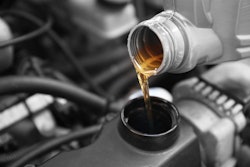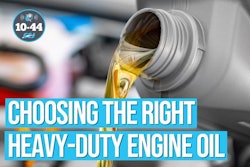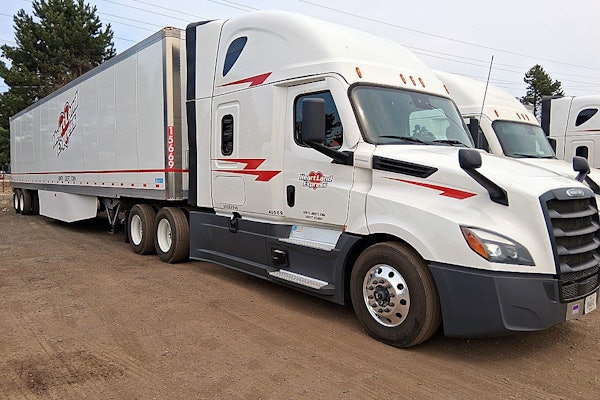Just like a blood test can show signs of a problem in the body, an engine oil sample can show signs of problems with your truck – even if that problem isn’t really associated with the engine oil itself.
Contents of this video
00:00 10-44 intro
00:27 Engine oil sampling
01:07 Biggest reason to do engine oil analysis
02:19 Sample kits
04:12 How much does engine oil sampling cost?
05:21 Quality of the engine oil sample
Speaker 1:
CCJs 10 44 is brought to you by Chevron Delo, heavy duty diesel engine oil. Now there's even more reasons to choose Delo engine oil Sampling isn't just about the quality of the oil itself. You're watching CCJs 10 44, a weekly episode that brings you the latest trucking industry news and updates from the editors of CCJ. Don't forget to subscribe and hit the bell for notifications, so you'll never miss an installment of 10 44. Hey everybody, welcome back. I'm Jason Cannon and my co-host is always on the other side is Matt Cole. When the doctor takes a blood sample, they're not really looking at the blood itself. They're analyzing all the information that's contained in the blood, like how your body's coping with illness, with an injury, inflammation or looking for an infection.
Speaker 2:
Blood tests can also help diagnose diseases like cancer, diabetes, or coronary heart disease, among many other things. In that regard, blood samples are a lot like engine oil samples.
Speaker 1:
Now, just like blood tests can show signs of a problem in the body, an engine oil sample can show signs of problems with your truck, even if that problem really isn't associated with the engine oil itself.
Speaker 3:
The biggest reason to do oil analysis is to prevent failures. In my personal opinion, the biggest investment is to be able to maintain that piece of equipment and keep it out of the shop as much as possible. That's the first thing. If the truck's in the shop and it's waiting on parts, it's not making any money. If it's not on the road, it's not making money for the company. If you are out on the road and all of a sudden you have have a spontaneous failure, then you're on the side of the road and then you've got towing expenses, what to do with the driver, et cetera, what to do with what's in the trailer of the haul, having to deal with all that expense, whether that's a cam shot, failure to fuel getting into the engine, which will thin the oil out and cause metal. Metal contact coolant gets in there and people think that if I've got a coolant leak, you're going to see a milky color. Yes and no, because a lot of times that engine is so hot that it'll burn that water off and you're left with sodium and potassium, which are elements and you can't really see those. Those has to go into the lab and the lab will see it on an induced plasma spectrometer or an ICP
Speaker 2:
Oil sampling can sound like a sophisticated ordeal, but it's really not. If you don't have a lubricant supplier rep, Shelly says you can reach out to any lab you want or even by a sample kit off the shelf at a part store or dealership.
Speaker 3:
This is going to sound hilarious, but Google it. But you can also go and get sample kits at Wix, Napa, CarQuest, John Deere, caterpillar dealers, Detroit dealers. There's sample kits everywhere, so you could always get a sample kit from the lab itself. You can have a house kit from the lab too, so from companies like a LS Triology, Polaris, which happens to be the two providers that we use for our Chevron Loop Watch program. And then of course, you want to make sure that you use a quality lab, one that is ISO certified so that you know that the test results are accurate and you're getting what you're paying for to begin with anyway. And again, your lubricant advisor can help you with that, whether that's your marketer or whether that's your national account rep or the lab, you can always Google and go to the lab.
Speaker 2:
So we've established that pulling a sample is a pretty valuable tool and it's not even hard to find a sample kit. So how much does it cost? Well, Shelly breaks that down after a quick word from 10 44 sponsor Chevron lubricants.
Speaker 4:
We serve customers from Birmingham, Alabama to the Gulf Coast, so our people and our trucks are booked solid all day. There is no slack in our schedules. These trucks can't break down. I choose an engine oil that takes care of the number one issue with our engines emissions, so we don't have to worry about DPF clotting. I choose the engine oil that keeps our trucks hauling. I choose delo 600 A DF.
Speaker 3:
The cost-effective way to do this is to use what I say as a branded kit. So that could be from Chevron Lube Watch or the Shell Program or the mobile program or one of the dealers get those kits from them because buying them as a group, so they're buying more samples than the individual person on the street, and that includes even going and getting a kit from Napa CarQuest. They're buying a group rate, so for basic analysis, less than 15 bucks, $15, but then again, it goes back to that return on investment. If you're looking at the calculation of what your expense is to do the maintenance of this equipment and then you calculate that out and divide it up by your cost of your sample kit, it typically outweighs it. As soon as you have a failure like that, that's when you recognize the fact that a sample kit is minuscule in cost compared to that failure, and that's what you're trying to prevent by doing all analysis. Right?
Speaker 2:
Less than $15 per sample is probably less than a hundred dollars over a year unless you're dropping oil a lot sooner than OEM recommended levels. But it really all comes down to the quality of the sample and how it's pulled and submitted.
Speaker 3:
What we were talking about is a vampire pump that doesn't always work well, and this is the second way it takes samples that ideally, there's sampling valves that are on the market with various fittings so that you can find a place on the engine block to get it into the block pressurized size of the block, and then just for instance, this one has a dust cap on it and you would unscrew it, and then you'd have a needle that would go inside of that. You'd flush the port just a little bit and you take another sample that makes it so that the sample is taken at exactly the same spot. Every time you take a sample and there's lots of sampling valves on the market, it should be mid drain. But what you consider mid drain and what I consider mid drain are two different things.
And you're right, if you take it too quick, you're going to get ghosts in the oil analysis if you take it too late. You could also get ghosts in the oil analysis because you want to get a nice representative sample in that middle of that sump. When a truck sits, it settles, right, so when the engine might have a bunch of lack of a scientific word gunk at the bottom of the sump before they take the sample instead of a representative sample, and if it's too late, then it might suck down some more gunk back into the oil sample. Again, not a representative sample.
Speaker 1:
That's it for this week's 10 44. You can read more on ccj digital.com. While you're there, sign up for our newsletter and stay up to date on the latest in trucking industry news and trends. If you have any questions or feedback, please let us know in the comments below. Don't forget to subscribe and hit the bell for notifications so you can catch us again next week.










